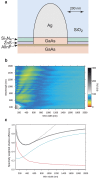Cloaking of solar cell contacts at the onset of Rayleigh scattering
- PMID: 27339390
- PMCID: PMC4919638
- DOI: 10.1038/srep28669
Cloaking of solar cell contacts at the onset of Rayleigh scattering
Abstract
Electrical contacts on the top surface of solar cells and light emitting diodes cause shadow losses. The phenomenon of extraordinary optical transmission through arrays of subwavelength holes suggests the possibility of engineering such contacts to reduce the shadow using plasmonics, but resonance effects occur only at specific wavelengths. Here we describe instead a broadband effect of enhanced light transmission through arrays of subwavelength metallic wires, due to the fact that, in the absence of resonances, metal wires asymptotically tend to invisibility in the small size limit regardless of the fraction of the device area taken up by the contacts. The effect occurs for wires more than an order of magnitude thicker than the transparency limit for metal thin films. Finite difference in time domain calculations predict that it is possible to have high cloaking efficiencies in a broadband wavelength range, and we experimentally demonstrate contact shadow losses less than half of the geometric shadow.
Figures




References
-
- Meulenberg A. The sawtooth coverslide-A new means of coupling light into solar cells. J. Energy 1, 151 (1977).
-
- Schumann M. F. et al.. Cloaked contact grids on solar cells by coordinate transformations: designs and prototypes. Optica 2, 850 (2015).
-
- Hsu P.-C. et al.. Performance enhancement of metal nanowire transparent conducting electrodes by mesoscale metal wires. Nature Comm. 4, 2114 (2013). - PubMed
-
- Wu H. et al.. A transparent electrode based on a metal nanotrough network. Nature Nanotech. 8, 421–425 (2013). - PubMed
-
- Van Beijnum F. et al.. Quasi-cylindrical wave in expericontribution ments on extraordinary optical transmission. Nature 492, 411 (2012). - PubMed
Publication types
LinkOut - more resources
Full Text Sources
Other Literature Sources

